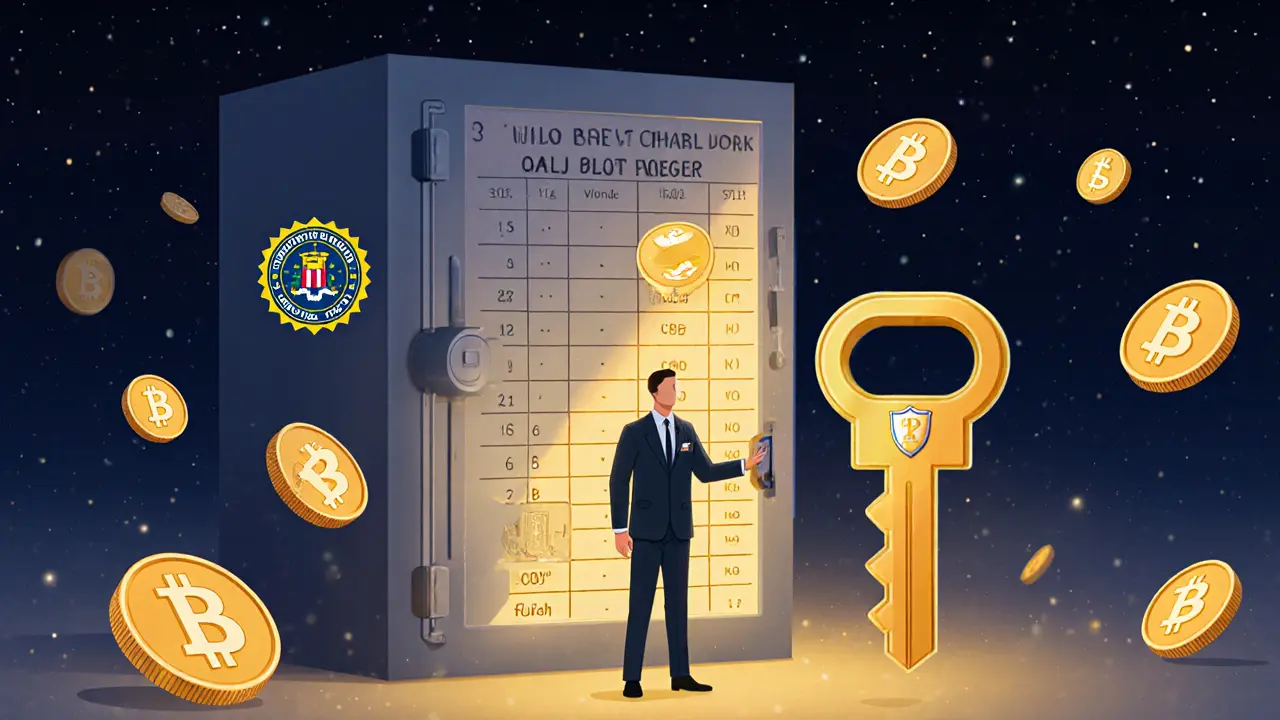Crypto Seizure Risk Calculator
Your Risk Assessment
When the U.S. government quietly added over 207,000 Bitcoin to a secret reserve in March 2025, it wasn’t just hoarding digital gold. It was rewriting the rules of how nations handle stolen crypto. For the first time, seized cryptocurrency wasn’t being sold off to fund police departments-it was being held as a sovereign asset, like oil or gold, with a long-term strategy behind it. This wasn’t an isolated move. Across the world, governments are getting serious about seizing crypto, not just as evidence, but as financial tools in their own right.
How Countries Are Seizing Crypto-And Keeping It
The U.S. didn’t just change its policy; it built a new system. The Strategic Bitcoin Reserve now holds more than $17 billion in forfeited cryptocurrency. This isn’t a temporary stash. It’s a permanent fund meant to stabilize markets, pay victims, and fund future investigations. Instead of dumping seized Bitcoin on exchanges and crashing prices, the government holds it. If Bitcoin rises, the reserve grows. If it falls, the government doesn’t panic. It waits.
Other countries are watching-and following. Spain’s Guardia Civil teamed up with U.S. agencies in early 2025 to freeze a $400 million crypto laundering network. Germany has created dedicated crypto asset units within its financial crime division. Japan’s Financial Services Agency now requires exchanges to report all seized wallets to a national registry. Even Russia, often seen as crypto-friendly, has started seizing wallets linked to sanctions evasion, using blockchain analytics to trace transactions.
The legal shift is simple: crypto is now treated as property. That means it can be seized under the same laws that let authorities take cash, cars, or real estate from criminals. Courts in the U.S., Canada, and the U.K. have already ruled that NFTs and DeFi tokens can be forfeited too. A hacker who stole an NFT from a digital art gallery? That NFT can be seized. A DeFi protocol used to launder money? Its smart contracts can be frozen.
Where the Biggest Seizures Are Happening
Not all countries are seizing crypto at the same rate. The U.S. leads in total value seized-not because it has the most crime, but because it has the most resources, the most advanced tools, and the clearest legal framework. In the first half of 2025, U.S. agencies recovered over $1.2 billion in crypto, more than the rest of the world combined.
But when you look at seizures per capita, smaller countries are catching up. Lithuania, for example, seized over $80 million in crypto in 2025 despite having a population of just 2.8 million. That’s more than $28 per person. Israel, with its strong tech sector and high crypto adoption, saw a 300% jump in crypto seizures compared to 2024. South Korea, where over 10% of the population owns crypto, has created special cyber units that work 24/7 to track wallet movements.
Meanwhile, countries with weak enforcement are seeing the most theft. The UAE, Chile, and India had the highest average loss per victim in H1 2025. That doesn’t mean they’re the most targeted-it means their users are holding large amounts of crypto and aren’t protected by strong regulations. A single phishing attack in Dubai can net a criminal $5 million. In Nairobi, the same attack might get $50,000.

Who’s Getting Hit the Most?
Crime follows adoption. The countries with the most crypto theft are also the ones with the most users. Ukraine, Moldova, and Georgia topped the 2025 Global Crypto Adoption Index-not because they’re rich, but because crypto is a lifeline. In Ukraine, where inflation hit 25% and banking access is unstable, people use crypto to send money, pay bills, and save. That makes them targets.
North America leads in Bitcoin theft. Europe leads in Ethereum and stablecoin theft. Why? Because Ethereum is used for DeFi, and stablecoins like USDC are used to move money fast. Criminals don’t want to hold Bitcoin for long-they want liquidity. So they target platforms where they can swap ETH or USDC for cash in minutes.
Eastern Europe, the Middle East, and Central Asia saw the fastest growth in crypto crime between 2024 and 2025. Why? Because those regions have rising internet access, growing digital payment systems, and lagging regulation. Criminals exploit the gap.
Legal Status Varies Wildly
Just because a country seizes crypto doesn’t mean it’s legal to own it. The rules are messy.
In Mauritius, crypto is fully legal and regulated. You can buy, sell, and hold it. But if you’re caught with stolen coins, the government can take them-and you get no compensation. In South Africa, crypto isn’t legal tender, but the tax office treats it as an asset. You owe capital gains tax on it. In Angola, crypto is legal, but the government tells people not to use it. In Namibia, banks can’t process crypto transactions. If you try to pay for groceries with Bitcoin, the store can refuse you-and the police can shut you down.
The U.S. is the outlier. It’s not just legal-it’s becoming institutionalized. Coinbase and Circle went public in 2025. The SEC no longer tries to shut down every new token. Instead, it tells companies: follow these rules, and you’re fine. That’s a huge shift. It’s no longer about chasing criminals. It’s about managing a new asset class.

Why This Matters for Everyone
If you hold crypto, this affects you. Governments aren’t just targeting hackers anymore. They’re tracking wallets, freezing accounts, and seizing coins from people who didn’t know they were receiving stolen funds. A friend sends you 0.5 BTC as a gift. Later, you find out it came from a hack. In the U.S., Canada, and the U.K., you might have to return it-even if you had no idea.
And if you’re running a business that accepts crypto? You’re now on the hook for KYC and AML checks. In the U.S., if you process a transaction with a blacklisted wallet, you could face fines. In the EU, you’re required to report suspicious transfers within 24 hours. In some countries, even holding crypto without a license is a crime.
But there’s a silver lining. The U.S. reserve strategy shows governments are learning. Instead of panic-selling, they’re holding. That means less market volatility. Instead of punishing every user, they’re focusing on bad actors. That means more clarity for honest users.
What’s Next?
The next big move will be international coordination. Right now, a criminal in Russia can send stolen crypto to a mixer in Turkey, then to an exchange in Singapore, and finally to a wallet in Brazil. Tracking that takes cooperation. The U.S. and Spain’s joint operation was a sign of things to come. Expect more cross-border task forces, shared blockchain analytics tools, and global blacklists of known criminal wallets.
Some countries will keep banning crypto. Others will embrace it. But one thing is clear: crypto isn’t going away. And neither are the seizures. The question isn’t whether governments will take your crypto. It’s whether they’ll do it fairly, transparently, and with real consequences for the criminals-not just the users.
Can the government take my crypto if I didn’t break the law?
Yes, in some cases. If your wallet receives stolen crypto-even accidentally-you may be required to return it. In the U.S., Canada, and the U.K., authorities can freeze or seize assets linked to criminal activity, even if you’re not the thief. That’s why exchanges now require KYC and warn users about suspicious deposits. If you get crypto from someone you don’t know, there’s risk.
Which countries are the strictest on crypto seizures?
The U.S. leads in both volume and sophistication. It has the Strategic Bitcoin Reserve, dedicated cyber units, and clear legal authority to seize and retain crypto. The U.K. and Germany follow closely, with strict reporting rules and joint operations with U.S. agencies. South Korea and Japan have aggressive enforcement too, especially on exchanges. In contrast, countries like Venezuela and Nigeria have high crypto use but weak enforcement, meaning seizures are rare-even when crimes happen.
Are NFTs and DeFi tokens really subject to seizure?
Yes. U.S. courts have ruled that NFTs are property under forfeiture laws. If someone steals an NFT from a gallery or uses a DeFi protocol to launder money, authorities can freeze the associated wallets. In 2025, the FBI seized over 1,200 NFTs linked to ransomware payments. DeFi tokens tied to illegal smart contracts have been frozen by the SEC and CFTC. Blockchain doesn’t make you invisible-it just makes your trail easier to follow.
Why does the U.S. keep seized crypto instead of selling it?
Selling seized Bitcoin all at once would crash the price and hurt victims who are owed restitution. By holding it in the Strategic Bitcoin Reserve, the government avoids flooding the market. If Bitcoin’s value rises, the reserve grows. That money can later be used to pay victims, fund investigations, or even buy more Bitcoin. It’s a long-term financial strategy, not a quick cash grab.
Is it safe to hold crypto in countries with weak regulation?
Not really. Countries with weak regulation often have the highest theft rates. If there’s no legal recourse, you can’t get your crypto back. In places like India, Chile, or the UAE, victims rarely recover stolen funds. Even if local police don’t seize your crypto, foreign agencies might freeze it if it’s linked to a global crime. The safest approach is to use regulated exchanges, enable two-factor authentication, and avoid unknown wallets.
What’s the difference between crypto seizure and crypto ban?
Seizure means the government takes crypto that’s linked to crime. Ban means you’re not allowed to own or use it at all. Namibia bans crypto. The U.S. seizes it. In a ban, you can’t buy Bitcoin legally. In a seizure, you can buy it-but if it’s stolen, they can take it back. Most countries that allow crypto still seize it. Only a few ban it outright.
